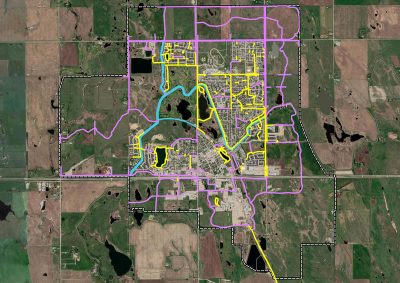Pathway expansion makes easier choice
By Sean Feagan, Local Journalism Initiative Reporter

By better linking the town’s pathway network to downtown, the Strathmore Commons project could lead more residents to choose active transportation for commuting and everyday trips.
Strathmore residents love their pathways – community pathways and trails are the most used recreation infrastructure in Strathmore, used by nearly 90 per cent of respondents of a survey conducted in 2019 – but reported wanting the system enhanced. A major step towards this is the Strathmore Commons project, which will better link Gray’s Park to Kinsmen Park, via new pathways.
Recreation is often highlighted when pathways are discussed, but it is when this infrastructure is used for other purposes that active transportation in a city or town really takes off, explained urban planner Marcus Bowman.
“Sometimes municipalities design their active transportation network around this idea of going for a Sunday bike ride with the kids along trails and stuff like that, which is great, but if you really want to get utility out of it, then it should be useful,” he said. “The trails have to go to actual destinations.”
Most trips people take are short, start from home and serve a distinct purpose other than recreation, such as shopping, visiting the library or travelling to school or work, explained Bowman. “So (the network) should connect people from their houses to commercial centres and libraries.”
Strathmore’s size makes is ideal for active transportation, as five kilometres is considered the “sweet spot” for trip length in the planning world, he said.
Once people start using the network to complete these trips, investment in pathways starts to pay real dividends. “Then you are not only just providing a recreational tool, but you’re also providing a tool to reduce traffic congestion and provide other benefits – healthier lifestyles, fewer accidents and less pollutants – all that good stuff.”
There can be commercial benefits too. “We’ve found that a lot of times, people biking the local area who make frequent, short trips actually spend more money than people who drive infrequent, longer trips.”
Therefore, the business case for active transportation is “always fantastic,” said Bowman. “There’s a lot of benefits and they are super cheap.” The cost of pathways are low and their maintenance requirements are less than that of a road, he added.
Pathways can also be “hitched” to other infrastructure projects to save costs. “Because they’re smaller, you can take them through things – a lot of cities do that by linking it with stormwater management.”
Strathmore Commons includes pathways that will approach, if not travel through, the town’s downtown and the Strathmore Municipal Library, thereby enhancing the functional connectedness of the town’s pathway system.
The Town of Strathmore has been working to expand and improve its pathway network, especially since 2011 when it participated in the Alberta Walkability Roadshow, an effort to enhance walkability in the town and to encourage citizens to walk. A professional workshop during this initiative identified “connectivity,” meaning the interconnectedness of the Strathmore’s pathway system, as a key part of enhancing Strathmore’s pathway network, explained Strathmore town Councillor Bob Sobol.
“We have actually been following that document; we have walking as a priority in regards to our planning,” said Sobol. “Now, it’s just something that is naturally discussed.”
Major milestones in improving the town’s pathway connectivity was the installation of three bridges going across canals in town serving as key links between its communities, he said.
While the sense of urgency to develop an active transportation network may be less in small towns like Strathmore than in large urban centres where traffic congestion is rampant, there’s still reasons for motivation.
“Maybe it’s purely quality of life, or maybe it’s safety, to provide a safe place for children to commute to school,” said Bowman. “It’s not like only big cities need active transportation – it works just as well in small towns; actually, it probably works even better.”
